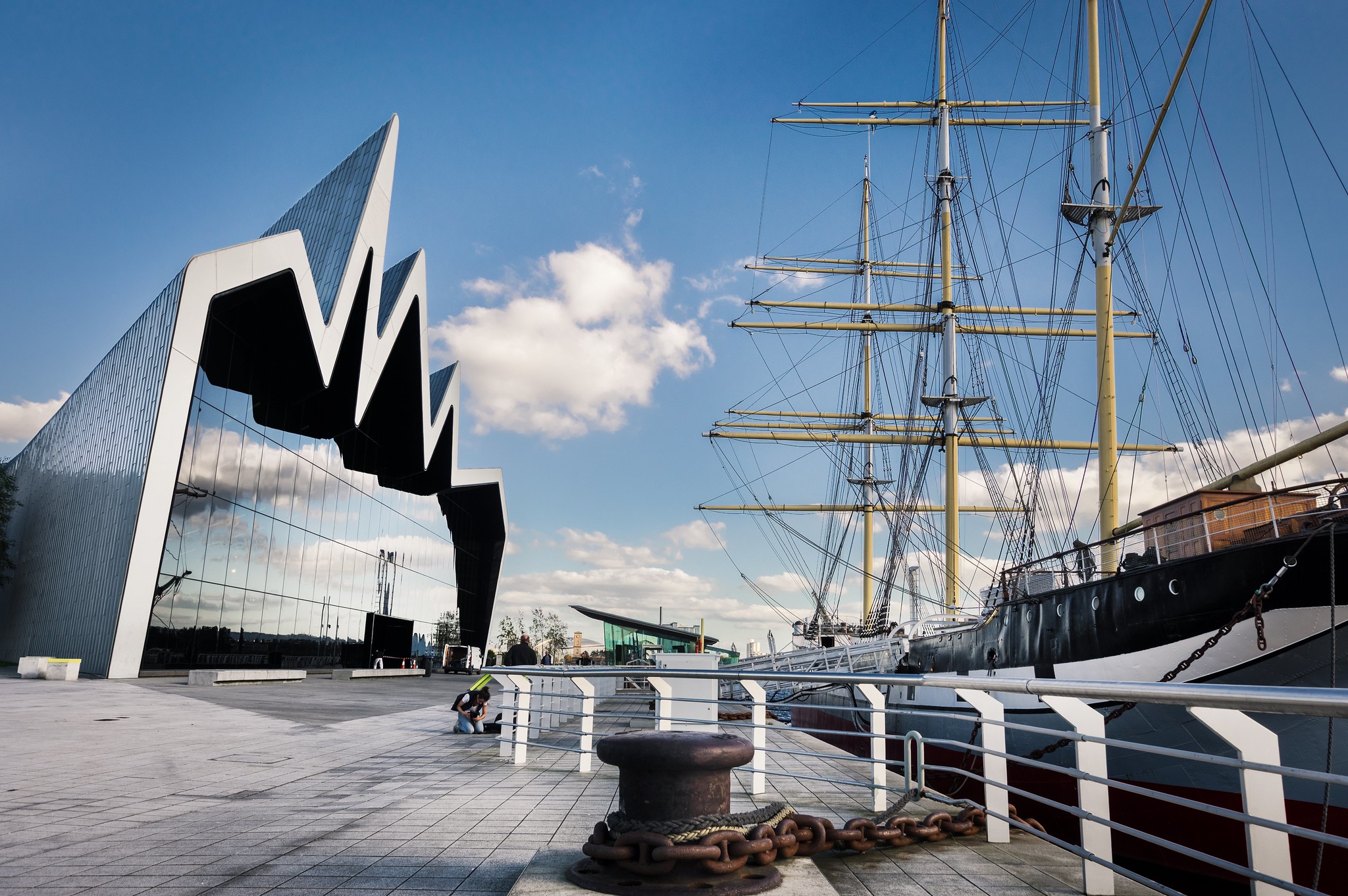The Riverside Museum, located in Glasgow, Scotland, is a modern transportation and technology museum that opened in 2011. Designed by renowned architect Zaha Hadid, the building’s striking zinc-clad exterior resembles a wave or pleated fabric. The museum houses over 3,000 objects showcasing Glasgow’s rich industrial heritage and the evolution of transport, from vintage cars and locomotives to bicycles and ship models. It also features interactive displays and a reconstructed historic Glasgow street. The museum’s waterfront location on the River Clyde is significant, as it sits at the former site of the A. & J. Inglis Shipyard, connecting visitors to the city’s shipbuilding past. The Riverside Museum has won several awards, including the European Museum of the Year Award in 2013, and attracts hundreds of thousands of visitors annually.
Glasgow’s Riverside Museum stands as a testament to the city’s rich industrial heritage and its forward-thinking approach to urban design. Nestled along the banks of the River Clyde, this striking structure has become an iconic landmark since its opening in 2011, drawing visitors from far and wide to marvel at its innovative architecture and fascinating exhibits.
The museum’s design is the brainchild of acclaimed Iraqi-British architect Zaha Hadid, known for her bold and futuristic creations. Hadid’s vision for the Riverside Museum was to create a space that would not only house Glasgow’s transport and technology collections but also serve as a dynamic piece of art in its own right. The result is a building that seamlessly blends form and function, challenging traditional notions of museum architecture.
At first glance, the Riverside Museum’s most striking feature is its dramatic zinc-clad exterior. The building’s undulating roof resembles a series of waves, paying homage to the museum’s riverside location and Glasgow’s maritime history. This fluid design creates a sense of movement and energy, inviting visitors to explore what lies within. The structure’s pleated facade, reminiscent of the folds in a piece of fabric, adds depth and texture to the exterior, creating an ever-changing play of light and shadow as the sun moves across the sky.
As visitors approach the museum, they’re greeted by expansive glass walls that offer tantalizing glimpses of the exhibits inside. This transparency not only floods the interior with natural light but also blurs the boundaries between the museum and its surroundings, creating a seamless connection between the building and the city beyond. The glass facade also serves a practical purpose, allowing passersby to see the vintage trams and locomotives on display, piquing their curiosity and drawing them inside.
Once inside, visitors are immediately struck by the museum’s cavernous interior. The vast, column-free space spans an impressive 7,000 square meters, providing ample room for the museum’s diverse collection of over 3,000 objects. The absence of internal supports creates an open, airy atmosphere that allows for flexible exhibit layouts and encourages visitors to explore freely. The building’s unique shape is even more apparent from within, with the undulating roof creating a series of dramatic curves and angles overhead.
One of the most innovative aspects of the Riverside Museum’s design is its approach to storytelling. Rather than presenting exhibits in a linear fashion, the museum’s layout encourages visitors to create their own paths through history. Interactive displays and immersive environments bring Glasgow’s transport and technological heritage to life, allowing visitors to step back in time and experience the city’s past firsthand.
The museum’s commitment to sustainability is evident in its design as well. The building incorporates numerous eco-friendly features, including a rainwater harvesting system, energy-efficient lighting, and natural ventilation. These elements not only reduce the museum’s environmental impact but also serve as educational tools, demonstrating the importance of sustainable design to visitors.
As the sun sets, the Riverside Museum takes on a new character. The building’s exterior is illuminated, transforming it into a glowing beacon along the River Clyde. This dramatic lighting not only enhances the museum’s architectural features but also serves as a metaphor for Glasgow’s bright future, built on the foundations of its industrial past.
In the years since its opening, the Riverside Museum has become more than just a repository for historical artifacts. It stands as a symbol of Glasgow’s regeneration and its commitment to innovative design. The museum’s unique architecture continues to inspire and captivate visitors, proving that a building can be both a functional space for learning and a work of art in its own right.
The Riverside Museum stands as a testament to Glasgow’s rich industrial and transportation heritage. Its striking architectural design, extensive collection of vehicles and interactive exhibits offer visitors a compelling journey through time. The museum successfully blends education and entertainment, showcasing the evolution of transport and its impact on society. With its prime location along the River Clyde, the Riverside Museum not only preserves history but also contributes to the city’s cultural landscape and urban regeneration efforts. It remains a popular attraction for locals and tourists alike, cementing its place as a significant cultural institution in Scotland.

